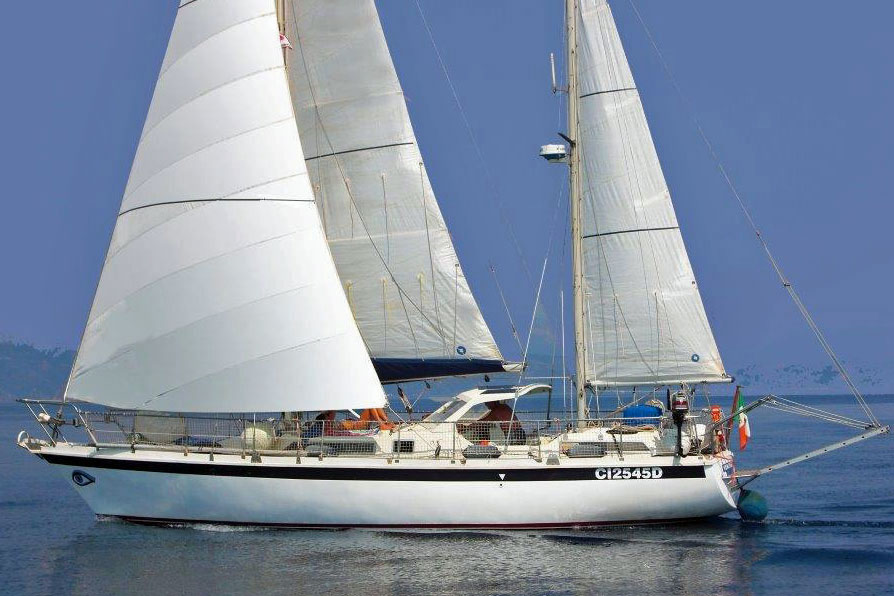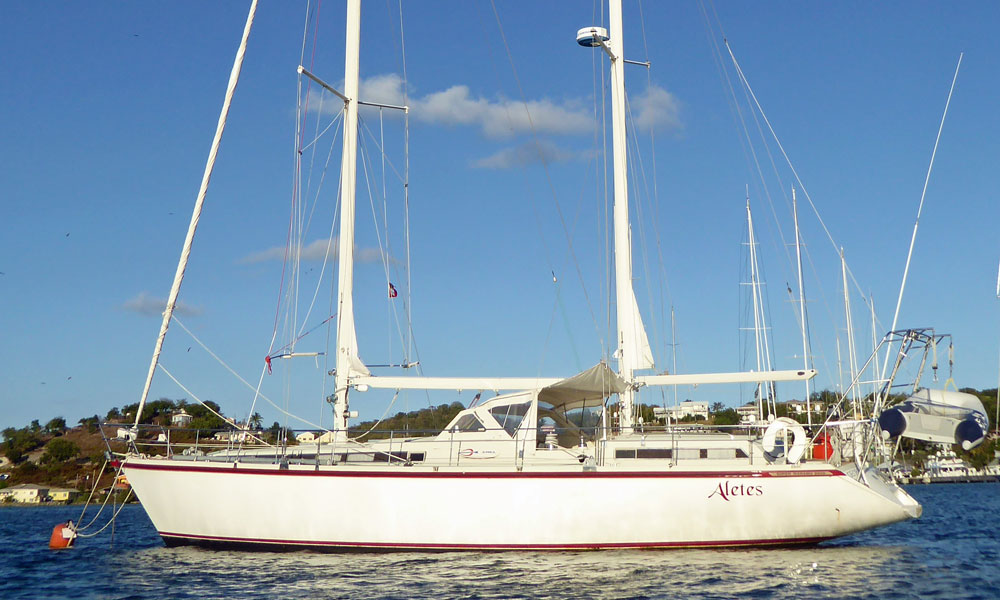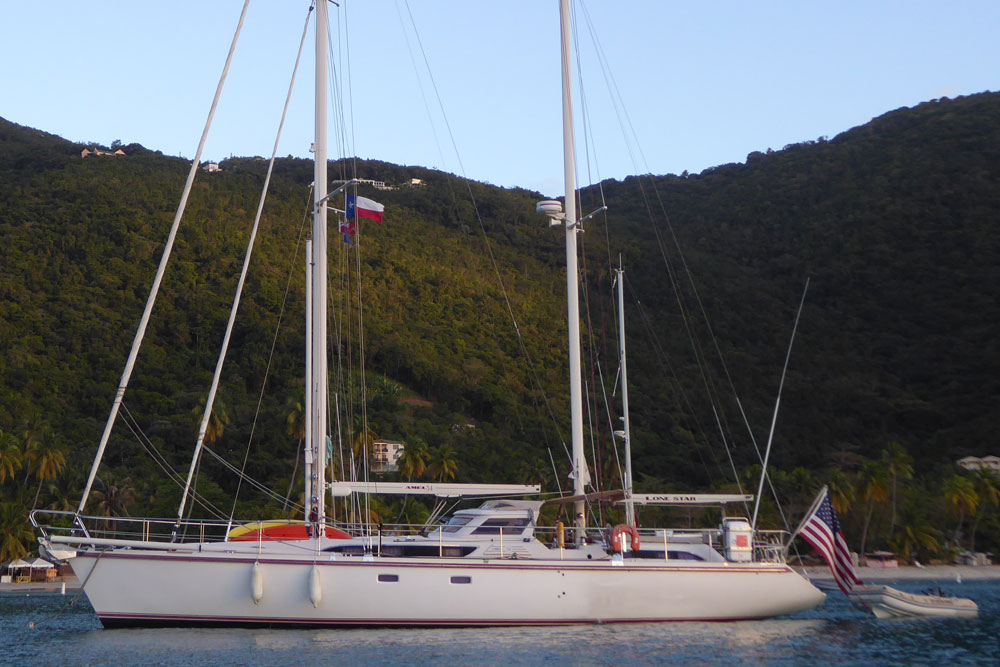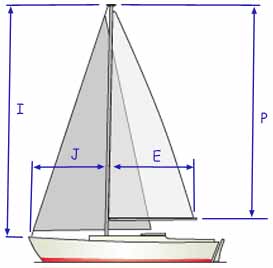- Home
- Cruising Yachts 35' to 40'
- Amel Sharki
The Amel Sharki Sailboat
Specs & Key Performance Indicators
The Amel Sharki ketch, designed by French naval architects Henri Amel and Jacques Carteau, was built by Chantiers Amel in La Rochelle, France. First introduced in 1979, the Sharki was produced until 1987.
 The Amel Sharki, a centre-cockpit ketch
The Amel Sharki, a centre-cockpit ketchPublished Specification for the Amel Sharki
Keel & Rudder Configuration: Fin keel & skeg-hung rudder
Hull Material: GRP (Fibreglass)
Length Overall: 39'3" (12.0 m)
Waterline Length: 31'10" (9.7 m)
Beam: 11'8" (3.6 m)
Draft: 6'1" (1.9 m)
Rig Type: Ketch
Displacement: 21,300 lb (9,662 kg)
Ballast: 7,060 lb (3,202 kg)
Designer: Henri Amel & Jacques Carteau
Builder: Amel (France)
Year First Built: 1979
Year Last Built: 1987
Number Built: 195
Sail Areas & Rig Dimensions
I: 45'11" (14.0 m)
J: 15'1" (4.6 m)
P: 40'0" (12.2 m)
E: 13'9" (4.2 m)
Sail Areas:
- Mainsail Area: 237 ft² (22 m²)
- Mizzen Sail Area: 108 ft² (10 m²)
- Genoa Area: 474 ft² (44 m²)
- Upwind Sail Area: 818 ft² (76 m²)
- Downwind Sail Area: 1001 ft² (93 m²)
Published Design Ratios
The Key Performance Indicators (KPIs)
- Sail Area/Displacement Ratio: 16.9
- Ballast/Displacement Ratio: 33.2
- Displacement/Length Ratio: 294
- Comfort Ratio: 36.6
- Capsize Screening Formula: 1.69
The following analysis of the primary design ratios gives an indication of the boat's likely sailing characteristics, but see the 'Notes of Caution' that follow below:
- Performance: With a Sail Area/Displacement Ratio of 16.9, the Amel Sharki falls within the range of 'reasonably good performance.' It should be able to achieve respectable boat speed and handle a variety of wind conditions.
- Stability and Power: A Ballast/Displacement Ratio of 33.2 suggests the Amel Sharki has good stability and can stand up well to strong winds. While not exceptionally high, this ratio indicates a good balance between stability and maneuverability.
- Displacement: The Displacement/Length Ratio of 294 places the Amel Sharki firmly in the 'Heavy Displacement' category. This means it will be more stable and comfortable in rough seas but might be slightly slower than a lighter displacement boat.
- Comfort: A Comfort Ratio of 36.6 indicates a 'reasonably sedate motion,' making the Amel Sharki well-suited for extended voyages and comfortable living aboard.
- Bluewater Capability: The Capsize Screening Formula of 1.69 is well below the 2.0 threshold, indicating the Amel Sharki is designed with bluewater capability in mind. The combination of its displacement and beam suggests good resistance to capsizing, making it suitable for ocean passages.
Overall: The Amel Sharki's design ratios point to a sailboat designed for a comfortable and safe bluewater cruising experience without sacrificing too much on performance.
Here's how to calculate the KPIs yourself - without having to wrestle with the mathematics...
Design Ratios: Notes of Caution...
- The Sail Area/Displacement Ratio (SA/D): This ratio provides an estimate of the sail power relative to the boat's weight, which can indicate potential speed in various wind conditions. But it doesn't account for the efficiency of the sail plan, the rigging, or the skill of the crew. Real-world performance can vary significantly based on these factors.
- The Ballast/Displacement Ratio (B/D): This ratio gives an idea of the boat's stability and stiffness, which is crucial for handling and safety. But it doesn't consider the distribution of the ballast or the hull shape, both of which can greatly affect stability. A high B/D ratio alone doesn't guarantee a stable boat if the ballast is poorly distributed.
- The Displacement/Length Ratio (D/L): This ratio helps predict the boat's speed potential and its behaviour in different sea conditions. But it doesn't account for the hull design or the boat's overall weight distribution. Two boats with the same D/L ratio can perform very differently if their hull shapes are different.
- The Comfort Ratio (CR): This ratio estimates the boat's motion comfort in a seaway, which is important for long passages. But it doesn't consider the boat's interior layout, which can also affect comfort. Additionally, personal tolerance to motion varies, so a boat that is comfortable for one person might not be for another.
- The Capsize Screening Formula (CSF): This formula assesses the likelihood of a boat capsizing in heavy seas, which is critical for offshore safety. But it doesn't take into account the boat's handling characteristics or the skill of the crew. A boat with a low CSF can still capsize if poorly handled in severe conditions.
General Limitations
- Static Nature: These ratios are static measurements and don't account for dynamic factors like wave action, wind gusts, or crew actions.
- Simplification: They simplify complex interactions into single numbers, which can be misleading. Real-world performance is influenced by a multitude of factors that these ratios can't fully capture.
- Context: The context in which the boat is used (e.g., coastal cruising vs. offshore racing) can greatly affect how these ratios should be interpreted.
In summary, while these ratios provide valuable insights into the theoretical performance characteristics of a sailboat, they should be used as part of a broader assessment that includes practical experience, sea trials, and expert advice.
The above text was drafted by sailboat-cruising.com using GPT-4 (OpenAI’s large-scale language-generation model) as a research assistant to develop source material; we believe it to be accurate to the best of our knowledge.
Other sailboats in the Amel range include:
 The Amel Santorini 46
The Amel Santorini 46 The Amel Super Maramu 2000
The Amel Super Maramu 2000 The Amel 54
The Amel 54.........................
I wrote this article using GPT-4, OpenAI’s large-scale language-generation model, as a research assistant to gather information, summarize research findings, and provide suggestions for the content and structure of the article.
Dick McClary, creator and owner of sailboat-cruising.com
.........................
Recent Articles
-
Is Marine SSB Still Used?
Apr 15, 25 02:05 PM
You'll find the answer to this and other marine SSB-related questions right here... -
Is An SSB Marine Radio Installation Worth Having on Your Sailboat?
Apr 14, 25 02:31 PM
SSB marine radio is expensive to buy and install, but remains the bluewater sailors' favourite means of long-range communication, and here's why -
Correct VHF Radio Procedure: Your Questions Answered
Apr 14, 25 08:37 AM
Got a question about correct VHF radio procedure? Odds are you'll find your answer here...













